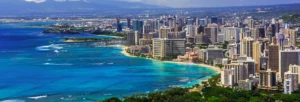Hawaii has once again opened its doors for domestic travel, less than six weeks after considering tightening restrictions. Governor Ige’s decision to dissolve the statewide Safe Travels program at midnight on March 25 coincides with the removal of indoor mask mandates and Covid-19 restrictions for intercounty travel within the state.
Before traveling to Hawaii, the Centers for Disease Control and Prevention (CDC) recommend that all children receive a series of vaccines before leaving the US. This includes at least one vaccination against tetanus, diphtheria and pertussis (Tdap), followed by boosters at least four months later. Furthermore, it is suggested that someone receive their hepatitis A vaccine at least four weeks prior to departing.
Vaccinations can be purchased at any pharmacy or health center, and digital versions through AZOVA, CLEAR and Common Pass serve as proof of immunization in addition to having a hard copy in your passport wallet upon arrival. Furthermore, travelers have the option to upload their vaccinations and other required documentation onto the free Safe Travels Hawaii website before departing.
At this link, you can check the current Hawaii vaccination requirements to make sure you have everything needed to enter without extra testing or quarantine. If you have a vaccination exemption or pre-travel test result, simply present that to airport staff so they can quickly process you through security.
If you have not received your vaccinations, the state of Washington requires you to complete a self-isolation period for five days after arriving and 24 hours after any fever has risen. It is essential that you adhere to the rules and instructions from the Office of Health and Human Services regarding travel isolation, including wearing an approved mask and clothing as instructed by the health department.
Once in self-isolation, wear an approved mask and dress in layers of clothing to stay covered up when outdoors – even during active observation periods. Try your best to stay out of direct sunlight and away from crowds as much as possible during this period.
The state’s Health and Public Safety Department urges visitors to avoid large groups of people as these can spread disease more rapidly. This is especially pertinent during peak tourist seasons like summer or during winter holidays such as Thanksgiving, Christmas, and New Year’s.
No matter your immunization status, Hawaii offers plenty to explore and experience. From stunning beaches and breathtaking scenery to traditional Pacific culture, Hawaii is a destination unlike any other in the world.
When visiting Hawaii, it’s essential to be prepared for all weather conditions. Have adequate protection from the sun and wind as well as from raindrops.
Temperatures on the islands differ, with lows in January ranging from the 60s on Kauai to the 50s on the Big Island. It’s also important to remember that humidity levels remain high which may cause some discomfort.